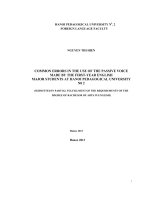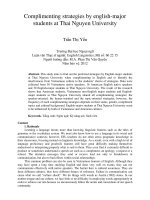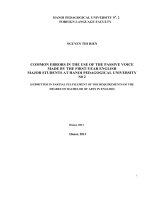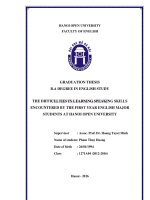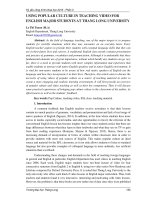Exploring difficulties caused by cultural differences in interpreting vietnamese into english faced by final year english major students at ha tinh university
Bạn đang xem bản rút gọn của tài liệu. Xem và tải ngay bản đầy đủ của tài liệu tại đây (753.11 KB, 40 trang )
HA TINH UNIVERSITY
FACULTY OF FOREIGN LANGUAGES
TRAN THI HUYEN
(11131302007)
GRADUATION MINOR THESIS
EXPLORING DIFFICULTIES CAUSED BY CULTURAL
DIFFERENCES IN INTERPRETING VIETNAMESE INTO
ENGLISH FACED BY FINAL-YEAR ENGLISH-MAJOR
STUDENTS AT HA TINH UNIVERSITY
Ha Tinh, May, 2017
HA TINH UNIVERSITY
FACULTY OF FOREIGN LANGUAGES
GRADUATION MINOR THESIS
EXPLORING DIFFICULTIES CAUSED BY CULTURAL
DIFFERENCES IN INTERPRETING VIETNAMESE INTO
ENGLISH FACED BY FINAL-YEAR ENGLISH-MAJOR
STUDENTS AT HA TINH UNIVERSITY
SUPERVISOR: DAU THI MAI PHUONG, M.A.
STUDENT RESEARCHER: TRAN THI HUYEN
CLASS: K6 ENGLISH LANGUAGE
STUDENT NUMBER: 11131302007
Ha Tinh, May, 2017
i
ACKNOWLEDGEMENTS
In the process of completing this graduation paper, I have face up with
many problems with lexicology, as well as the way to express my ideas.
However, with the great help, assistance and encouragement from teachers,
family and friend; I have overcome these difficulties and completed this
graduation paper successfully.
First of all, I would like to express my deepest gratitude to Mrs. Dau Thi
Mai Phuong, M.A, who has not only given me many invaluable suggestions
and comments but also provided me with valuable materials.
Secondly, I am deeply grateful to Mr. Nguyen Gia Viet, PhD – Dean of
Foreign Language Faculty of Hatinh University whose criticism and advices
have improved my study.
In addition, I would like to thank other teachers of Foreign Language
Department for their lessons during 4 years that formed the basis of my study.
Last but not least, my sincere thanks are delivered to my parents and friends
for their encouragement and assistance in this time.
Ha Tinh, May 2017
Student
Tran Thi Huyen
i
ABSTRACT
This thesis focuses on difficulties caused by cultural differences in
interpreting Vietnamese into English faced by English majored final year
students at Ha Tinh University. The difficulties are analyzed with data taken
from questionnaire for 40 participants.
ii
TABLE OF CONTENTS
Page
ACKNOWLEDGEMENT
i
ABSTRACT
ii
TABLE OF CONTENTS
iii
TABLE AND FIGURE
vi
CHAPTER ONE: INTRODUCTION
1
1.1. Rationale of the Study
1
1.2. Aims of the Study
2
1.3. Research questions
3
1.4. Scope of the Study
3
1.5. Significance of the study
3
1.6. Organization of the Study
3
CHAPTER TWO: DEVELOPMENT
5
2.1. Literature review
5
2.1.1 What is culture
5
2.1. 2. What is cultural differences communication
7
2.1.3. Cultural differences between Vietnam and British
8
2.1.4. Culture shock
8
2.1.5. How cultural differences influence on language
9
2.1.6. Interpreting
10
2.1. Methodology
11
2.1.1. Research approach
11
2.1.2. Participants
12
2.1.3. Instruments for data collection and analysis of this study
12
2.1.3.1. Questionnaires
12
2.1.3.2. Samples
13
iii
2.2.4. Interviews
13
2.2.5. Procedures of data collection
13
2.3. Findings
13
2.3.1. Students’ perceptions of the cultural differences
13
2.3.1.1. The influence of cultural differences on language
13
2.3.1.2. The importance of cultural differences awareness in
15
interpreting Vietnamese into English
2.3.1.3. Frequency of dealing with cultural difference in interpreting
16
2.3.1.4. Evaluation on the difficulty caused by cultural differences in
17
interpreting Vietnamese into English
2.3.2. Common language difficulties caused by cultural differences in
17
interpreting Vietnamese into English of HTU senior English-majored
students
2.3.2.1. Traditional words
17
2.3.2.2. Idioms
22
2.3.3. Strategies HTU senior English-majored students use to deal with
23
difficulties caused by cultural differences in interpreting Vietnamese
into English
2.3.3.1. Using tools
24
2.3.3.2. Consultant
25
CHAPTER THREE: CONCLUSION
26
3.1. Summary
26
3.2. Implications
26
3.2.1. For the students
26
3.2.2. For the teachers
27
3.3. Limitation of the study
27
3.4. Suggestions for further research
27
iv
References
29
Questionnaire
31
v
TABLE AND FIGURE
Table 2.1. Methods used in interpreting Example 1
Table 2.2. Methods used in interpreting Example 2
Table 2.3. Methods used in interpreting Example 3
Table 2.4.Methods used in interpreting Example 4
Table 2.5. Methods used in interpreting Example 5
Chart 2.3.1.1. Influence of cultural differences on language
Chart 2.3.1.2. Importance of cultural differences on interpreting awareness
Chart 2.3.1.3. Frequency student dealing with cultural differences in
interpreting
Chart 2.3.1.4. Difficulty in interpreting Vietnamese into English evaluation
vi
CHAPTER ONE: INTRODUCTION
This chapter firstly presents the rationale of the study in which the
background of the research and the reasons for the research are given by the
researcher. Moreover, aim of the research, research questions, research
scope, significance of the study, and the organization of the research paper
are also presented.
1.1. Rationale of the study
Nobody can deny the importance of English. Together with the economic
globalization trend, English has been more and more popular. It is considered
the international language or the lingua franca all over the world. English,
therefore, is used widely in all aspects of the daily life such as science,
business, entertainment, Internet, and so on. Being a member of WTO -World
Trade Organization nowadays, Vietnam opens the door to other countries in
the world. Vietnamese people have more chances to join the dance of
exchange with those from many foreign countries. Moreover, due to the rapid
development of science, technology, internet, many people have to work on
various documents, e-mails, contracts, news, etc., most of which are in
English. For the crowd-pleasing demand, the number of people who want to
learn and use English increases evidently.
Since I was small, English is my favorite subject, I always dreamed about
being able to communicate with Western people frequently. Then, I was very
excited that I could be an English major student in Ha Tinh University.
During 4 years studying English language there, I have been taught to study
English in a professional way.
Among subjects for English majors at my university, interpreting is one of
the most difficult language practicing skills. I found that converting English
1
(Vietnamese) to Vietnamese (English) as frequently as possible is not as
simple as I thought. So I have been interested in observing and guessing what
difficulties influencing on my as well my classmates’ interpreting.
Except for the different criteria of expression, there are similar difficulties
between translation and interpreting. Benfoughal (2010) carried out 5
difficulties
in
translation
including:
grammatical,
lexical,
stylistic,
phonological and cultural problems. According to him “the cultural specific
expressions are some how difficult to translate, even professional translators
find it difficult to deal with them.”
Moreover, he suggests that “The interpretations may completely different
as they may just slightly different, subtle overlaps. The differences between
cultures and life perceptions from a society into another may cause a lot of
problems to translators; it creates a lot of gaps which lead to plenty of
overlaps between language pairs. Hence, the translation task is going to be too
complicated.”
Agree with Benfoughal (2010), I realize that compared to the other four
difficulties, cultural difficulties are hard to face with and find solutions.
In my opinion, cultural difference is always confused me to convert source
language into target language. Moreover, being lack of knowledge about
culture background is one of reasons that students deal with wrong
explanation. The inadequate cultural background can cause the problems or
even disaster in interpreting. Therefore, I decided to do the research in
difficulty caused by cultural differences for major English senior students.
1.2. Aims of study
This study is targeted at identifying the cultural differences difficulties in
interpreting faced by English-majored seniors at Ha Tinh University. Besides,
the writer wants to clarify how English-majored seniors overcome cultural
2
differences difficulties in interpreting. As a result, some useful strategies to
deal with these kinds of problems will be presented.
1.3. Research questions
In order to fulfill the aim above, the study focuses on answering these
following questions:
1. How do English major senior students at Ha Tinh University think
about the influence of cultural differences on interpreting?
2. What difficulties caused by cultural differences do they have when
interpreting?
3. What do they often do to solve the problem?
1.4. Scope of the study
A cross culture is a very large scale. However, due to limitation of my
knowledge as well as experience and time, only interpreting difficulty caused
by cultural differences is taken into consideration. But hopefully, these will
partly help people have general knowledge and understanding about cultural
differences to get easier in interpreting.
1.5. Significance of the study
The fact shows that interpreting Vietnamese into English is a difficult
process. As a language learner, I have found that a great number of final year
English major students at Ha Tinh University encounter a number of
difficulties in interpreting Vietnamese into English caused by cultural
differences. I hope that the strategies suggested in the research paper will
make some necessary changes in the current learning and teaching of
interpreting. Thus, the teaching and learning process can be fruitfully carried
out in classes.
1.6. Organization of the study
Chapter one: Introduction.
3
This chapter presents the rationale, the aims, the research questions, the
scope, and the organization of the study. This part provides a general look at
the study.
Chapter two: Development
The chapter consists of 4 main parts:
2.1. Literature review
2.2. Methodology
2.3. Findings
2.4. Discussion of findings
Chapter three: Conclusion.
This chapter includes
3.1. Summary of the study
3.2. Implications and Suggestions
3.3. Further research
4
CHAPTER TWO: DEVELOPMENT
This chapter focuses on the theoretical background of the study. It
includes a number of important theoretical terms and then previous studies
related to the research were mentioned. The part also presents in details the
findings and discussion on the result of the study.
2.2. Literature review
2.2.1. Definition of culture
Culture is the knowledge and characteristics of a particular group of
people, including definition of language, religion, cuisine, social habits, music
and arts. The word “culture” comes from a French term, which derived from
the Latin “colure” means to tend to the earth and grow, or cultivation and
nurture.
The Cambridge English Dictionary firmly states that culture is the way of
life, especially the general customs and beliefs, of a particular group of people
at a particular time.
Besides, there are hundreds of researchers analyzed about culture
definition.
We can also see definition of culture from “Primitive Culture” (1871)
written by Tyler, she defined culture as “ that complex whole which includes
knowledge, beliefs, art, morals, laws, customs and any other capabilities and
habits acquired by man as a member of society”.
According to Kroeber (1952), culture is “the historically differentiated and
variable mass of customary ways of functioning of human societies”
In his research, Tannin (1984) suggested that “culture is everything you
have ever learned about how to communicate and how to think about things –
which comes down to the same thing”
5
A definition summarized from Wikipedia, culture is a general term for
social behaviors and norms found in human societies. Culture is a central
concept in anthropology, encompassing the range of phenomena that are
transmitted through social learning in human societies.
Shock (1970: 1) suggested: “Culture, in its broadest sense, is what make
you stranger when you are away from home. It includes all belief and
expectation about how people should and act which have become a kind of
second nature to you as a social learning. When you are with members of a
group who share your culture, we or you do not have to think about it, for you
are all viewing the world in pretty much in same way and you all know, in
general terms, what to expect of one another.”
Hoopes (1973: 3) consider culture as “the sum of ways of living, including
valuableness, beliefs, esthetic standards, linguistic expression, patterns of
thinking, behave norms, and styles of communication which a group of
people develop to assume its survival in a particular physical and human
environment. Culture and the people who are part of its interact. So culture is
not static. Culture is the response of a group of human beings to valid and
particular needs of its member. It, therefore, has an inherent logic and an
essential balance between positive and negative dimensions.”
Levine and Alelman (1993) defines that: “Culture is a shared background
(for example national, ethnic, religious) resulting from a common language
and communication style, customs, beliefs, art, music and all the other
products of human thought made by a particular group of people at a
particular time. It also refers to the informal and often hidden patterns of
human interactions, expressions and viewpoints that people in one culture
share”.
6
Culture is the product of discourse communities in term of society and
history, created by language and action. Culture is always changing to be
fitted to people belief and behavior in particular time. Obviously, language
and culture cannot occur alone and are never separated.
2.2.2. Definition of cultural differences communication
Culture and communication depend on each other. Culture can be viewed
as a part of communication, the way people communicating is affected by
culture. That means people from different cultural background should
communicate in different way. Cultural difference is not only affected
between national difference, but also different social status, education,
institutional memberships into professions.
As mentioned in his report, Dr. Prasanta (2016) asserted that
“communication barriers generally arise due to the absence of understanding
between parties to the dialogue. Culture tends to create different attitudes and
approaches to problem solving”
According to Richards (1985: 92), “cultural differences communication is
an exchange of ideas, information, etc. between persons from different
backgrounds. There are more problems in cultural differences communication
than in communication between people of the same cultural background. Each
participant may interpret the other’s speech according to his or her own
cultural conventions and expectations. If the cultural conventions and
expectations, if the cultural conventions and misunderstandings can easily
arise, even resulting in a total breakdown of communication. This has been
shown by research into real life situation, such as job interview, doctor –
patient encounters and legal communication”.
Kramsch (1998: 81) states cultural differences as “the meeting of two
cultures or languages across political boundaries of nation – states”.
7
2.2.3. Cultural differences between Vietnam and British
There are many anthropologists researched about differences of culture
between Eastern and Western society. Vietnam can be considered as a
representative of Republican agricultural society, in contrast, British is a
Capitalism country. Besides living in different environment, people in Eastern
and Western are educated in distinctively different ways.
The culture of Vietnam is one of the oldest in Southeast Asia, with the
ancient Bronze age, Dong Son culture being widely considered one of its
most important progenitors. Due to a millennium of Chinese rule, Vietnam
was heavily influenced by Chinese culture in terms of politics, government,
Confucian social and moral ethics and art. Vietnam is considered to be a part
of the East Asian cultural sphere. (Wikipedia – Culture of Vietnam)
Whereas, the culture of the United Kingdom is influenced by the UK’s
history as a developed island country, a liberal democracy and a major power;
its predominantly Christian religious life; and its composition of four
countries – England, Wales, Scotland and Northern Ireland – each of which
has distinct customs, cultures and symbolism. The wider culture of Europe
has also influenced British culture, and Humanism, Protestantism and
representative democracy developed from broader Western culture.
(Wikipedia – Culture of the United Kingdom)
2.2.4. Culture shock
Culture shock is defined on Wikipedia as a term used to describe the
anxiety and feelings (of surprise, disorientation, confuse, etc.) felt when
people have to operate within an entirely different cultural or social
environment, such as a foreign country. It grows out of the difficulties in
assimilating the new culture, causing difficulty in knowing what is
8
appropriated and what is not. This is often combined with strong disgust
about certain aspects of the near or different culture.
Harries and Moran (14: 226) suggest that “culture shock is neither good or
bad, and necessary or unnecessary”.
Valdes (1995) defines culture shock as a common experience for a person
learning a second language in a second culture, referring to phenomena
recognizing from mild irritability to deep psychological panic and crisis. It
associated with feeling in the learners of estrangement, anger, hostility,
homesickness and even physical illness.
Foster (1962: 87) announces that “culture-shock is mental illness, and is
true of much mental illness, the victim usually does not know he is affected.
He finds that he is irritable, depressed, and probably annoyed by the lack of
attention shown him”.
Culture shock is the consequence of adapting to the new environment
caused by the movement of different cultural backgrounds.
2.2.5. The influence of cultural differences on language
Sapir (1996) indicates that “the close relationship between language and
culture, concluding that it was not possible to understand or appreciate one
without knowledge of the other”.
However, Wardhaugh (2002:220) reports three claims to the relationship
between language and culture.
The structure of a language determines the way in which speakers of that
language view the world or, as a weaker view, the structure does not
determine the world-view but is still extremely influential in predisposing
speakers of a language toward adopting their world-view
9
The culture of a people finds reflection in the language they employ:
because they value certain things and do them in a certain way, they come to
use their language in ways that reflect what they value and what they do
The ‘neutral claim’ which states that there is little or no relationship
between the two.
Brown (1994:165) describes language as a part of a culture and a culture is
a part of a language, they are intricately interwoven so that one cannot
separate the two without losing the significance of either language or culture.
It is known that Vietnamese and English are two distinctive languages.
This is shown in the way of using different word-classes for one idea.
Vietnamese is considered as Austro-Asiatic original, derived from the
agricultural civilization. The official language in Vietnam is Vietnamese, but
in Vietnam more than 10 dialects that are very different from each other
coexist, this particular feature makes Vietnamese extremely different from
English.
Moreover, due to differences in perspective Vietnamese is distinguished
from English in terms of time, habits. For example, Vietnam has special
customs such as "thách cưới" that England does not include. Vietnamese
believe in the Buddhism and spirit world, ancestor worship is what any
Vietnamese do.
The differences mentioned above affect language, it is difficult to look at
the traditional words of the two countries for comparison.
2.1.6. Interpreting
Interpreters are seen by their customers. They make face-to-face
communication possible. Interpreters speak in the first person and become the
voice of the speaker. They express the speaker’s ideas and convictions with
10
the same intensity and same shades of meaning, and without ever adding their
own views or comments.
Definition on Wikipedia suggests Interpretation or interpreting is oral
translation of speech or sign from a language into another. An interpreter is a
person who converts a thought or expression in a source language into an
expression with a comparable meaning in a target language either
simultaneously in "real time" or consecutively when the speaker pauses after
completing one or two sentences.
2.3. Methodology
2.3.1. Research approach
Within social science, there are two major research approaches. They are
quantitative and qualitative research.
According to McMillan and Schumacher (1993, p.191) “quantitative
research relies heavily on numbers in reporting results, sampling and
providing estimates of instruments reliability and validity.” Because
quantitative research was statistical analysis to determine the results, it
effectively provides an objective view of the data without the interference of
the researchers’ subjectivity. However, a part from these strong points,
quantitative also have some weak points such as failure to provide the
researcher with the information on the context of the situation, limited
outcomes to only those outlined in the original proposal because of close type
questions. Meanwhile, “qualitative research describes and analyzes people’s
individual and collective social actions, beliefs, thoughts, and perceptions”
(McMillan and Schumacher, 1993, p.372). By using it, researchers can gain
more insights on their behaviors and put them in the relationship with natural
settings. (Punch, 1998).
11
In order to make the study more reliable and objective as well as to make it
more convincing, both of quantitative and qualitative approaches are used in
this study.
To collect data, different methods of study are used. Firstly, the author
conducted a survey on investing knowledge of students about cultural
differences. Moreover, researcher searched data from books and reference
materials collected from books, internet, television, dictation, exchanged with
teachers and friends. In order to have the insight of the reality and confirm the
data collected, interview is conducted.
2.3.2. Participants
These participants are 40 English major senior students come from Hatinh
University who studied about interpreting skill for 2 semesters and three
teachers who taught interpreting.
2.3.3. Instruments for data collection and analysis of this study
2.3.3.1. Questionnaires
The database is collected from the survey questionnaire. In order to collect
sufficient data for analysis, the author designed two types of survey
questionnaire:
four
multiple-choice
questionnaires,
three
comment
questionnaires. All of these them are design on website Monkey Survey.
These questionnaires is designed for 40 participants to investigate how
they know about cultural differences and its influence on interpreting then
investigate their solutions to deal with difficulty caused by cultural difference
in interpreting.
The questionnaire has 4 parts:
Part 1: Investigate perception of participants about culture and its
influence on interpreting Vietnamese into English.
12
Part 2: Suggest some easily obvious difficulties caused by cultural
difference to investigate participants solving ability.
Part 3: Survey how participants deal with these difficulties.
2.3.3.2. Samples
There are five samples designed to survey interpreting ability of HTU
final English major students relating to cultural differences.
2.3.4. Interviews
After the questionnaire was collected, 10 participants were randomly
chosen to interview in order to get the insight into difficulties and strategies
students used to deal with their translation of conditional sentences. All the
interviews were recorded with the participants’ permissions. The results were
presented in the form of themes verbalized and quoted to illustrate the
findings of this study.
2.3.5. Procedures of data collection
All of questionnaires are designed on SurveyMonkey. After completing
questionnaires standard, survey link was sent to all participant through their
email. For who do not provide their email, survey link would be sent on
Facebook. The samples were given directly to the participants. All interviews
were carried out directly and recorded with the informants’ permissions. The
data collected were analyzed statistically and the results were presented in
form of percentage and mean score, illustrated by table and chart.
2.4. Findings
2.4.1. Students’ perceptions of the cultural differences
2.3.1.1. The influence of cultural differences on language
13
80%
75%
70%
60%
50%
Absolutely
40%
A little
30%
20%
7.50%
10%
12.50%
Not sure
about it
5%
0%
Absolutely
A little
Not sure about Absolutely not
it
Chart 2.3.1.1. Influence of cultural differences on language
It is obvious to see that most of participants believe in the impact of
language on culture. More than 70% of students completely agreed that there
was a relationship between culture and language. The table also showed that
there are 7.5% of students insignificantly understand and 5% of them did not
ensure. The figure of the number of students who totally stated that there was
no relationship between language and culture was 12.5%.
Base on the database showed in this chart, I would like to claim again that
most of participants affirmed that language is influenced by culture. Indeed,
language and culture have a straight connection and relation with each other.
Because language is an instrument for transmitting culture to that end, this
implies no language can exist in the lack of culture. The human ability of
learning language is strongly based on their realizing level and their
domination on culture. If someone has rich information in the field of
language learning but neglect from cultural matter, this negligence causes
awkward mistakes in learning language. The language cannot exist without
culture (Hayati, 2011).
14
According to Emmitt & Pollock (1997), language is rooted in culture and
culture is reflected and passed on by language from one generation to the
next.
Language and culture support each other, the way people use language is
closely relating to language, culture is expressed through the way people use
language. Understanding the relationship and influence between language and
culture helps participants aware why there are difficulties caused by cultural
differences when interpreting.
2.3.1.2. The importance of cultural differences awareness in
interpreting Vietnamese into English
As mentioned above, differences from distinct culture cause languages
thought. However, many people do not recognize this, that is the reason why
many amateur interpreters often misunderstanding their customers of cultural
factors. An investigation was created among participants to survey how they
aware about cultural differences in interpreting.
120.00%
97.00%
100.00%
80.00%
Absolutely important
60.00%
Important
A little
40.00%
Not at all
20.00%
0%
0%
3%
Important
A little
Not at all
0.00%
Absolutely
important
Chart 2.3.1.2. Importance of cultural differences on interpreting
awareness
15
The chart 2.4 indicates that 97% of participants find cultural differences
very important in interpreting Vietnamese into English. This data shows that
participants might encounter problems related to cultural factors in
interpreting.
2.3.3.3. Frequency of dealing with cultural difference in interpreting
40%
35%
35%
30%
30%
25%
25%
Always
20%
Often
Sometimes
15%
10%
Never
10%
5%
0%
Always
Often
Sometimes
Never
Chart 2.3.1.3. Frequency student dealing with cultural differences in
interpreting
As shown in chart 2.5, the number of students who always deal with
cultural difference in interpreting reaches at 30%. There are 35% of the
students suggested that they sometimes saw cultural differences difficulties in
their interpreting and 10% of them claimed that they never find it hard to deal
with difficulties caused by cultural differences.
The data shown in the chart reflects that the average frequency of
participants facing the difficulty caused by cultural differences is quite high.
The reason is predicted that they are not fully equipped to deal with the
difficulties.
16
2.3.3.4. Evaluation on the difficulty caused by cultural differences in
interpreting Vietnamese into English
This section reflects the participant's assessment of the influence of
cultural factors affecting on interpreting Vietnamese into English.
60%
50%
50%
40%
40%
Very difficult
30%
Difficult
Not really difficult
20%
Easy
10%
10%
0%
0%
Very difficult
Difficult
Not really
difficult
Easy
Chart 2.3.1.4. Difficulty in interpreting Vietnamese into English
evaluation
2.3.4. Common language difficulties caused by cultural differences in
interpreting Vietnamese into English of HTU senior English-majored
students
Difficulties caused by cultural differences are difficult to face not only for
students even for professionals. This section focuses on the common language
difficulties participants encountered when dealing with interpreting
Vietnamese into English.
2.3.2.1. Traditional words
17

